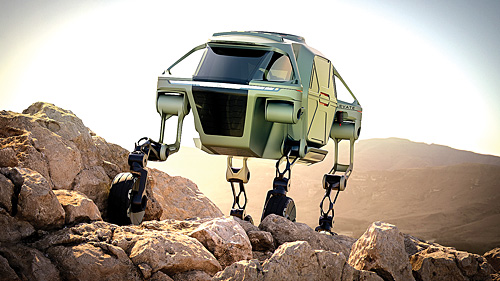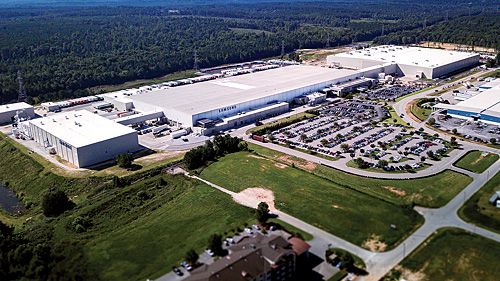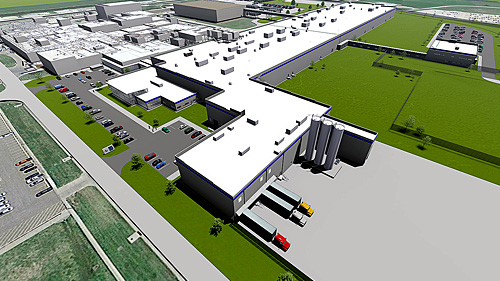Available land, lower costs, and the desire to co-locate with suppliers and customers draw companies to rural locations, but satisfying infrastructure needs and access to talent shouldn’t be overlooked.
By John W. McCurry Q3 2022 (source article)

Hyundai chose Bozeman as the location for its New Horizons Studio, a research, development, and lab center focused on the evolution of ultimate mobility vehicles (UMV), which can travel over terrains challenging for conventional ground vehicles. The facility is being developed at Montana State University’s Innovation Campus.
John Suh, a vice president with Hyundai Motor Group, will head New Horizons Studio. He says the search for New Horizon’s home was handled in-house, noting he was familiar with Montana as a vacation attraction but had not previously thought of it from a business viewpoint.
Rife with Resources
Suh says Hyundai’s project is about developing alternative mobility via the addition of robotics to a car design. Montana, he believes, offers a great setting for testing of the vehicles and a great potential future market in areas such as mining and energy exploration.
“That leads us to look at areas with a wide range of natural resources, whether it is agricultural, ranch land, or forest,” he says. “There are a lot of places in Montana where such a vehicle could add value. It is important to be close to our potential customer and close to the scenarios where our vehicle can provide value.”
Hyundai also wanted a place rife with talent, where the company could “ease into position as the premier employer” for engineering talent. Hyundai’s project will serve to keep talent at home, Suh says.“There aren’t many companies like us in Montana. In Bozeman, there is a great school, Montana State University, producing a lot of engineering talent, but in many cases, there have been limited local career opportunities for their graduates.”
Hyundai considered other locations but kept coming back to Montana’s distinctiveness and the potential for the company to be a unique employer in the region. Asked if Hyundai might eventually locate a UMV manufacturing facility in Montana, Suh notes design and manufacturing of vehicles usually occur in two different places. “But I do believe in Montana we will find the market and customer base that will make sense to also do our manufacturing here. But that decision has not been made yet,” he notes.

Site consultants say many of the qualities that lure companies to rural settings are the same as urban locations. At the top of the list are land, labor, and educational opportunities.
The Lure of Rural Settings
Hyundai’s need for rugged terrain for vehicle testing makes it somewhat of an anomaly, but in general, site consultants say many of the qualities that lure companies to rural settings are the same as urban locations. At the top of the list are land, labor, and educational opportunities.
Courtney Dunbar, director of site selection at global construction and engineering firm Burns & McDonnell, says decisions to locate in rural areas are typically the product of a proactive, rather than a reactive, approach. That makes it less consultant-driven.
Site consultants say many of the qualities that lure companies to rural settings are the same as urban locations. At the top of the list are land, labor, and educational opportunities.“More likely, it would be where there was an anchor industrial type, or an agrarian company, that may be located in an area that might be considered rural population-wise, but where there is a cluster of need up or down line. You’re either supplying to it, or you’re taking supply from it, to feed whatever is being manufactured or created in the operation that may site there,” she explains.
For example, Dunbar says, a location with a major food processor in a rural area may have packaging companies that may also wish to co-locate. Or it could be machining or smaller companies that deal with an equipment repair that may want to co-locate.
Clustered Together
“A lot of it has to do with the cluster,” Dunbar says. “It’s driven by the existing industry more than it would be by just randomly siting something on its own.”
Site advisor David Hickey, managing director at Hickey & Associates, notes the biggest challenge for manufacturers is securing suitable land. Rural America offers availability and cost advantages. Land and labor costs trend lower in rural areas.
“There can be a big opportunity in the lower cost of power and the access to power,” Hickey says. “However, at times, agricultural areas can have issues with available infrastructure and the amount of power transmission and conductivity can present a challenge.”
Rural America offers availability and cost advantages. Land and labor costs trend lower in rural areas.The Southeast continues to win big projects in lower populated areas. Hickey cited Tennessee, Georgia, the Carolinas, and Virginia as having done well in recent years in terms of bringing together state and local resources to attract projects.
“They are finding ways to find and develop the infrastructure to ultimately make these projects a reality,” Hickey says. “The infrastructure is a key issue. The industry wants to know what sites are ready today. What is it going to take to make it come together? They want to know what availability or challenges exist in order to access local power, water supply, and wastewater management, and what access is available to roads, rail lines, or ports.”
Quick Site Plans
Hickey and Dunbar say with projects moving so quickly today, site developers must plan two to three years ahead, to make sure sites are ready when needed.
“In a lot of instances, rural locations don’t have ready or prepared sites,” Dunbar says. “You have to be in a position where you can at least show that you prepare a site quickly. It demands diligence to get them to a shovel-ready perspective, versus a pre-built industrial park scenario, which can be very difficult for rural areas.
Look for a source of talent, such as technical schools or universities. Look at your market and gain knowledge of the customer, and educate them about you as well.John Suh, Vice President, Hyundai Motor Group“If I have something in the cluster that already exists, what is needed in the up and down line? Do I have raw product in my backyard that can be used to attract industry that can utilize that raw product? Logistics matter too in that equation. You must make sure your workforce somehow is higher in volume or skill level or both, to compete for certain industries.”
Rural sites offer more opportunities and often attract much larger projects, says James Chavez, president and CEO of the S.C. Power Team, the economic development arm of South Carolina’s 20 electric cooperatives.
“Especially in the last year, projects have gotten so big in scale,” Chavez says. “Most metro areas are now built out to the point that they cannot accommodate that kind of footprint. They are beginning to look at second-tier rural communities for sites.”
Development of rural sites presents a few challenges. First, developers must prepare a site for today’s fast-moving projects, Chavez adds. “If you don’t already have control of the property, if you’ve not engineered or acquired a right of way for whatever infrastructure will be required, you just can’t keep up with project timelines.”

The sprawling Samsung campus in Newberry, S.C., has steadily expanded over the past five years.
Highlight the Workforce Assets
The second challenge, which is the same for all communities, is providing a workforce. Chavez says being able to articulate workforce assets to companies is essential.
“Just because you are small does not mean you do not have a large-draw area, the ability to pull people in from a large radius,” Chavez says. “It’s essential to be able to know what skill sets those people have, and to be ready to communicate a proper and compelling workforce story. Knowing what your existing employers are going to say about their workforce is super-important. Any potential employer looking at a new area is going to want to talk to other employers to get a feel for the market.”
One of South Carolina’s biggest rural projects in recent years is Samsung’s sprawling complex in Newberry, about 40 miles northwest of Columbia. The Newberry site, which manufactures washing machines, recently passed the five-year mark. Initially operating in a vacant building formerly occupied by Caterpillar, Samsung has since expanded its footprint to 1.5 million square feet.
Samsung has invested about $500 million and created 1,600 jobs at its Newberry campus. Tom Komaromi, general counsel at Samsung Electronics Home Appliances America, says the company has also made progress with localization of its supply chain, bringing four major suppliers to the area.
Komaromi says Samsung ultimately chose Newberry for reasons including “an incredible workforce, a robust energy and transportation infrastructure, and local officials who are business ready and have a track record of success with international companies.”
Samsung’s site selection process took several months. “We developed an extremely aggressive timeline,” Komaromi says. “Just six months after our initial announcement, we opened the doors in Newberry and produced our first residential washing machine in the United States. Since that day, we are running two production lines with multiple shifts and have produced over four million washing machines.”

This illustration shows the 400,000-square-foot addition to Schwan’s footprint in Salina, Kansas.
Taking a Holistic View
An ongoing rural success story is Schwan’s Company’s growth over the decades in Salina, Kansas. Schwan’s acquired the Tony’s pizza brand in Salina in 1970. The facility has since grown from 18,000 square feet to 550,000 square feet, including a distribution center that was added in 2006. An expansion currently under way will add another 400,000 square feet to the complex. The company believes the facility will be the largest pizza plant in the world.
“We have been able to develop some great relationships through the years in Salina at the community, state, and federal levels,” says Schwan’s spokesman Chuck Blomberg.
“Generally speaking, you would typically find that operating in a rural area can be less expensive due to a lower cost of living, but this isn’t the only factor for us in choosing a location. We have facilities in both rural and more urban areas. We tend to look at a project holistically in how a specific location might benefit our business and the community.”
With that in mind, Hyundai’s Suh advises companies considering rural areas to examine the ingredients needed to make a successful business: “Look for a source of talent, such as technical schools or universities. Look at your market and gain knowledge of the customer, and educate them about you as well,” he concludes.


